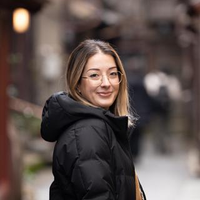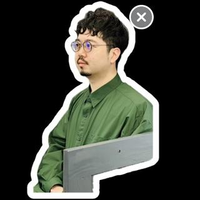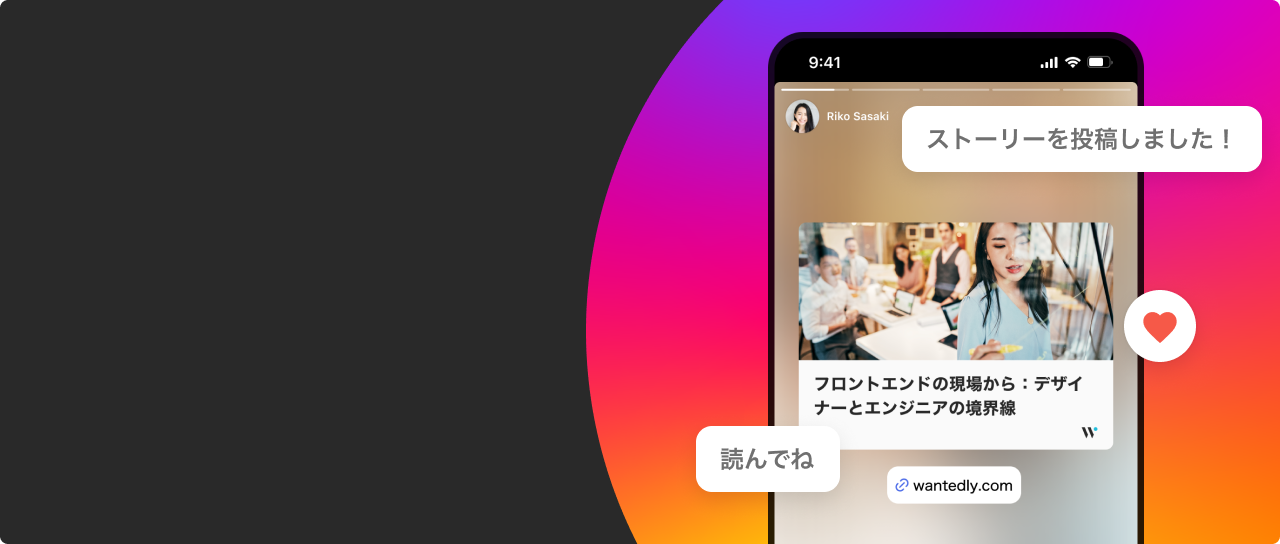Finding Value and Creativity in Japan: Shiitake Creative’s Graphic Designer On Facing New Challenges — And Opportunities — in Japan’s creative industry
Born and raised in Australia, Graphic Designer and artist Tyana Adamidis felt close to Japan long before she even thought of eventually making the country her second home. At first, a book on Japanese culture piqued her interest. Then, it was the uniqueness of Japanese design that slowly but certainly began influencing her artistic style. Several years later, it was love at first sight that brought it all together. The rest, she says, as she sits on her desk in central Tokyo, is history.
A resident of Japan since March 2022, Tyana joined Shiitake Creative as the in-house Graphic Designer in the same year. In her current role, she handles multiple projects, ranging from creating logo designs and various artworks for independent clients to handling nationwide campaigns to promote Japan to overseas travelers. When time permits, she also puts her creative skills and social media savvy into practice to spruce up the company’s social media channels. No day is the same at Shiitake, she says, admitting that navigating creativity in a new cultural landscape is often a challenge, but always a rewarding one. At Shiitake, she believes she has found a caring and healthy work environment where everyone speaks their minds and is valued for their contribution to the company.
We caught up with Tyana to hear more about her career transition from Australia to Japan, the creative challenges she has faced so far, and her future aspirations.
▼ Tyana Adamidis
Graphic Designer & Artist. After studying graphic design in Australia, Tyana Adamidis worked as an in-house graphic designer at a signage company before going freelance and eventually moving to Japan. In 2022, she moved to Japan to explore the world further. That same year, she joined Shiitake Creative Inc., where she manages multiple projects, in addition to social media marketing.

Starting fresh in Japan
Tell us a bit about your career prior to moving to Japan.
I graduated in 2014 with an Advanced Diploma in Graphic Design and landed my first graphic design role at a signage company. There we did all kinds of designs — large and small print jobs, building signage, logos, brochures, clothing, the list goes on.
During my time at that company, I was also really passionate about art and wanted to pursue this as a full-time gig. So, I ended up quitting my job to focus on my art business. My main source of income was from selling custom pet portraits, but I also sold my own personal-style artworks and painted murals. In addition to this, I continued doing freelance graphic design jobs and worked for big clients like Jetstar Australia.
So you’ve worked both in the corporate world and on your own, as a freelancer. What prompted you to return to the corporate world?
Working for myself was a really great experience and I learnt so much. However, after a couple of years, I felt that I needed a change and more stability in my life. At this point, I had committed to the idea that I was going to move to Japan by mid-2020 and wanted to save up as much money as possible by then. So, I ended up working for a popular electronics company in Australia in their customer service department.
Unfortunately, little did I know that at this time, moving to Japan in 2020 was a very, very far-off goal… but I made it here eventually!

The pandemic changed a lot of things, didn’t it? But luckily (for Shiitake, too), you finally made it to Japan in 2022! What motivated you to embark on such a massive journey in the first place? Why Japan?
When I was in high school, I read a book about Japan which sparked my fascination with Japanese culture and had a heavy influence on my own personal art style.
I always had fleeting thoughts about one day moving to Japan, especially after visiting a couple of times, but I never thought I would actually turn it into a reality.
In 2019, I met my Japanese partner, Ryosuke, who was living in Australia at the time but was going to move back to Japan. In a way, I felt like my stars had aligned and the next step for me, for us, was for me to move to Japan with him so that I could experience life here.
That was your first time living in a different country, wasn’t it? What was the transition process like? What were some of the initial challenges?
Naturally, there were quite a few challenges, but I’m very lucky to have a partner who has supported and guided me through my process of moving here, especially due to my limited Japanese language ability. He has helped me with filling out all kinds of paperwork, finding an apartment, and setting up a bank account. This has, and still is, helping me a lot. And I’m very grateful for all of that.
One of the first challenges we faced in Japan was finding an apartment because we aren’t a married couple and I’m a foreigner. So many real estate owners rejected us, which was honestly very difficult. But we made it eventually!
Compared to Australia, how different do you find life in Japan in general? How about in the workplace?
Life in Japan is very different from life in Australia. Australia has an overall laid-back and casual lifestyle, whereas I find that Japan is very orderly and hard-working.
I haven’t worked at a traditional Japanese company before, however, I can speak from my experience at Shiitake Creative that, due to our multicultural backgrounds, we adapt to both a hard-working and casual environment. This blend is really the best of both worlds.

New country, new creative opportunities
About half a year after moving to Japan, you started working at Shiitake Creative. How did that happen?
This is my first job in Japan. I came on a working holiday visa and was sure I would find a job in teaching, and I applied for a lot of them. But I decided to hold off for a bit, because I was hoping I could find a position that not only was within my field of design but also something that genuinely excited me. I didn’t want to just ‘settle.’
Then I found the Shiitake job on LinkedIn and thought it sounded great. It really stood out to me when I read the job description. I thought, “wow, this is really interesting,” because graphic design was obviously a part of it, but they also mentioned traveling around Japan to visit the places applying for the Japan Travel Awards (also run by Shiitake), and I really enjoy travel. I genuinely felt really enthusiastic about the position.
What are some of your main responsibilities at Shiitake? What’s a typical day on the job for you?
I regularly deal with a big client in creating Amazon optimization images and dummy boxes for multiple products. I also assist Jake, our art director, with designs. I even do some social media work for the Japan Travel Awards. Basically, I assist with design in every form; it’s not just one category, which is good.
Shiitake is very self-managed. So unless you’re given specific project-related tasks, you have to discipline yourself and set tasks for yourself. I will set certain tasks for myself every morning and then let the team know what I’m planning to do for the day. Anything that I’ve done during the day I’ll share with the team and let them know how it’s going, either verbally if we’re in the office, or via Slack if I’m working from home. It’s rare that I have to work overtime, but, of course, it happens sometimes.

It’s been almost a year since you joined the company. How does your Shiitake job compare to other jobs you’ve had in the past?
It’s probably one of the best jobs I’ve had, in terms of the work environment. And a big thing is feeling valued. I definitely don’t feel like just a number here, and that’s something that’s really important to me. I also feel like I’m a part of the entire operation and not just the graphic design, whereas at previous companies, I’ve felt like if they wanted to replace me, they could. Shiitake is also very open about things and I really appreciate this aspect.
That all sounds great, but we’re sure it’s not always fun and games. What are some challenges you face and how are they resolved?
One thing is that my Japanese ability isn’t great. So if there is any design work that requires Japanese text, I rely on a Japanese speaker to double-check it.
Sometimes there is also a clash between the western perspective of design and the very corporate Japanese perspective. You really have to find the balance of keeping the client happy while maintaining a good design. It’s all about balance, and I know that my way of thinking isn’t necessarily the “right” way of thinking, so it’s just a question of meeting halfway.
Seiya, our company’s CEO, handles the client relationship, so if there’s ever a time when I have a differing opinion from the client about the design and Seiya agrees with me, he’ll help communicate that to the client. But at the end of the day, it’s about what the client wants, and Seiya is very good at explaining the cultural context to me in cases like that.
Another difficulty can be the occasional difference of opinion. Because we all openly speak our minds, differences of opinion can occasionally cause small misunderstandings. However, we are able to resolve these quickly with thorough discussion. We achieve this by trying to listen, respect, and understand each other’s points of view. This helps us to grow and learn not only as individuals but also as a team.
What are some examples of a clash between Japanese and western perspectives in design that you’ve encountered so far? How was it resolved?
One example is when I was creating a company slide deck for a Japanese client. The target audience for this client deck was Japanese and non-Japanese. Generally, Japanese designs tend to use as little white space as possible. For my particular design, I incorporated white space as it suited the style of the slide deck. The feedback from the client came in and they wanted to fill up this space with text as it looked too ‘empty.’
To solve this issue, I ended up redesigning the layout of the style deck to meet the client’s request without compromising the design. Instead of filling up empty spaces entirely with text which can be overwhelming to view, I used elements such as coloured shapes, images and borders to create a more harmonious design. This way, the project would not only appeal to a Japanese audience but also an international audience which was the client’s goal.

That’s a great example that we’re sure the client also learned a lot from. What was their final feedback?
Oh, they actually loved it and approved it right away. (laughs)
For less than a year on the job, you’ve been involved in quite a few projects already, so this may be a hard one — What’s one of the most memorable projects you’ve worked on at Shiitake so far?
One of the most memorable so far would be a large-scale travel advertising project where we designed articles to be published in various newspapers and magazines across the world to promote several travel destinations in Japan to overseas readers. That project happened as soon as I first started at the company and I was really stressed because I felt inexperienced, and I was also just trying to get used to the environment of the company. But in the end, it was very rewarding because I had to learn a lot on the spot and I learned a lot. It was such a cool project because now our work’s printed in Europe and Asia!
I also love to work on designs for the Japan Travel Awards (JTA), including social media and web content. My interest in travel, Japan, and what JTA stands for really motivates me. Making posts and reels for our Instagram page is always fun because I love seeing how the account grows. I can also learn new skills such as videography and using programs like Adobe PremierePro. Being able to share some really special places in Japan with the world is also very exciting.
Shared values and responsibilities
What do you value most in the workplace?
I appreciate the fact that everyone’s opinion is valued and that you’re actively encouraged to speak up and speak your mind. I also like that everyone is friendly. I feel very comfortable at work and in expressing my opinion towards certain things.
I also feel like everyone is very constructive when they speak. We may not agree on everything, but I think everyone appreciates what each of us has to say. The whole team is very supportive of everything, and the work environment is very fun. But when we need to work, we work, and there is a mutual understanding between everyone.

Shiitake emphasizes diversity and inclusion and strives to incorporate them into its corporate culture and work. As a designer, do you think that these values are important in the creative industry as a whole?
I feel like these values are extremely important in the creative industry as design should not only be targeted towards particular groups of people, but all kinds of people from different abilities and backgrounds.
For example, those with visual impairments may find it difficult to view certain colors, so we need to take this into consideration when designing in order to allow this group of people to view designs without any difficulty.
This is something that you had to work on with the rebranding of an accessibility-focused website. Tell us a bit about your approach at the time and what you learned along the way.
Before I started working on this particular project, it honestly never crossed my mind that I needed to think about accessibility when designing, nor was I taught this in school. In order to find out what color palette I should or should not use on the website rebrand, I had to use a website www.accessible-colors.com. With this website, you can just add in your desired colors to check whether they are readable with text or not. This really made me think outside of the bounds of what I knew when it comes to design, and now I make sure that my designs are all accessible.
Sounds like you’re working on a lot of different projects, but what are your future aspirations at Shiitake? What projects would you like to be involved in next?
I’m currently really interested in videography and photography, it’s a skill I definitely want to improve on.
I would also love to continue to improve the company and the Japan Travel Awards. Overall, I’d just love to have made a contribution to the company’s success in a big way.
What kind of people do you think would fit in at Shiitake? What kind of new colleagues do you want to work with personally?
I think it can be summed up by three main points:
- Someone who isn’t afraid to speak up
- Someone who can manage their own tasks
- Someone who is open-minded
I think speaking up is very important, especially in a small start-up. The team values everyone's opinions. And it's maybe not totally necessary, but someone who comes from a multicultural background, or someone that is okay with being in that kind of environment.
Secondly, if you're someone who can manage their own tasks, and doesn’t need direction from people all the time, then Shiitake is probably for you. You need to be independent with the way you work, and happy to wear multiple hats.
Finally, it’s good to be open-minded. It’s a fun environment, but at the same time, there are going to be disagreements, especially because, being a startup, the company's finding its feet in a way too.
To anyone thinking of applying to Shiitake, I think it’s really important that your interests align with the company’s, or if the company resonates with you in any way. That’s how I felt about Shiitake, and look at me now. Anything is possible as long as you try!

So much to see and do: Life outside the office
Let's talk about work-life balance for a moment. How’s life for you outside of work? Do you feel settled here in Japan?
In some ways, I feel I have settled; in others, I feel I haven’t. Being away from home, specifically my family and friends, is still an adjustment. Making friends in a new country and as an adult can be quite challenging and something I wasn’t prepared for when moving here.
Apart from this, however, I feel that I have gotten used to daily life here in Japan. I have found a routine that works for me and keeps me feeling productive outside of work. On the weekends, I constantly explore new places and discover new things. Life is pretty good here!
We hear that you love traveling in your free time and that you create some pretty good reels online. What are some of your favorite places in Japan so far?
There are so many places that I really enjoyed visiting in Japan. To list just a few: Shirakawa-go, Kurashiki, Naoshima, Kamikochi, and Nara. I really loved cycling along the Kibi Plain in Okayama Prefecture, too. The cycling route passes through many historic sights and farms in the Japanese countryside, which was so beautiful.
I enjoy recording videos so I can make Instagram reels and Ryosuke takes my photos.
There are still so many places to explore in Japan and I’m looking forward to it in the future!
Lastly… if you could bring one thing from Australia that Japan doesn’t have, that would be?
A decently priced mango 🥭
Thank you for your time, Tyana!
Interview & text by Cassandra Lord



/assets/images/20692948/original/bc2a0d12-9dc2-47e7-9f65-271ec636d626?1742354573)

/assets/images/20692948/original/bc2a0d12-9dc2-47e7-9f65-271ec636d626?1742354573)

